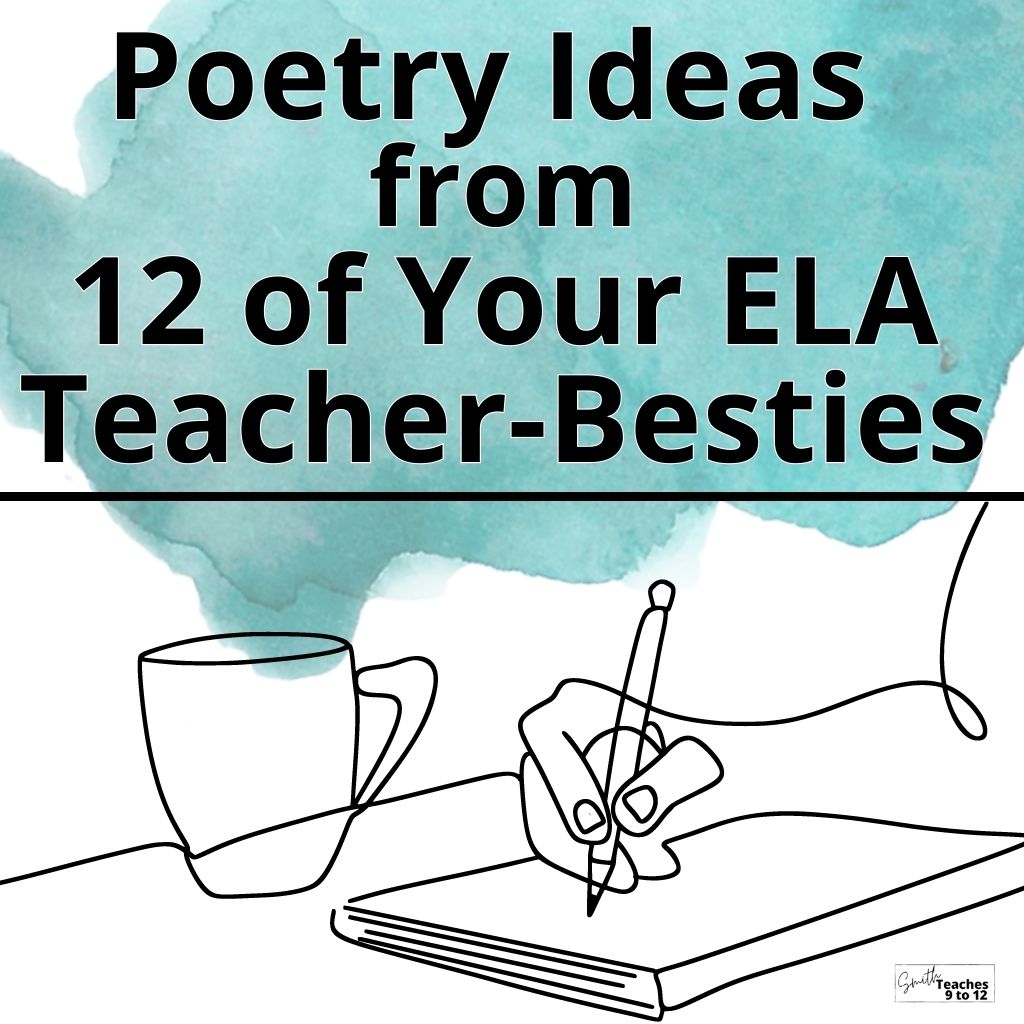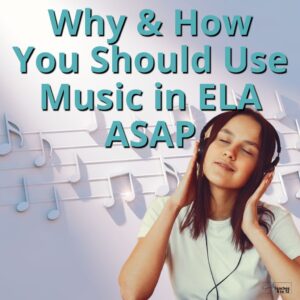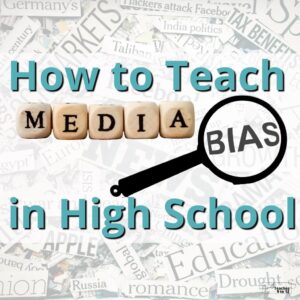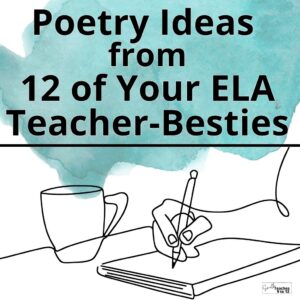Sharing is caring!
Do you ever wonder what other teachers are doing with poetry? What poetry ideas are they using in their classrooms? Well, for this post that’s exactly what I asked of a group of friends and fellow teachers. They let me pick their brains and were kind enough to share a variety of poetry ideas and activities they use in their own classrooms to engage their students while showcasing poetry.
Read on for any 32 poetry ideas that can be used in your middle school or high school English classroom tomorrow! And remember, while April is National Poetry Month, poetry can be used all year long!
Poetry Idea 1: Activities with Novels in Verse

Poetry has never been Samantha from Samantha in Secondary’s favorite topic. What she does love is YA novels. Samantha was surprised (and excited!) to find that she actually loves YA novels in verse, and she spent the last few years devouring tons of them. (Click here to see 10 of her favorites or here to see 10 YA favorites featuring poetry!)
It didn’t take long to figure out that novels in verse needed to be a part of Samantha’s curriculum. So, she began to brainstorm activity ideas. Here are a few of her favorites:
#1: Rewrite the Verse to Prose: This is a powerful activity that combines close reading and writing in an important way. Have students choose one of their favorite passages from any verse novel and rewrite it to traditional prose. This forces students to carefully select passages and closely read in order to rewrite the section correctly. This is a great way to reach those upper levels of lesson complexity.
#2: Find a Nonfiction Connection: Ask students to consider the themes of the novels in verse they are reading. Help them locate valid resources for nonfiction articles, such as NewsELA or CommonLit (where you can actually search by theme). Have them choose one or two articles that relate to the themes of their verse novels and describe the connection. This is a great way for students to really dig into the material.
#3: Create a Soundtrack: Song lyrics are poetry in and of themselves. For this activity, students should come up with a few songs that directly connect to the verse novels. Ask them to share a couple of lines of lyrics for each connection and explain it. They won’t even realize they are closely reading and analyzing text!
You can find two more activity suggestions as well as more information and examples of the activities above by visiting Samantha’s blog post here.
Happy teaching!
Poetry Idea 2: Poetry Analysis as a Conversation

Tackling poetry analysis can be intimidating for both teacher AND student. That’s why Amanda from Mud and Ink Teaching spent her time working on her Master’s Degree researching and building a framework that encouraged poetry as a conversation — not a “high-brow only” experience.
Using The Big Six, students can enter their conversation from any of the six spots on the circle: title, speaker, theme, tools, paraphrase, or turns. Each of these spaces can have their own lessons and students will develop comfortable places to start their analysis conversations.
Whether you’re just beginning your poetry journey with younger students or ready to push more advanced students, The Big Six Framework is the most teacher and student friendly tool out there. Come take a look at Amanda’s top 30 poems to use with The Big Six and her ready to go lesson plans and student workbook!
Poetry Idea 3: Poetry and Basketball

Poetry and basketball? Yes, please! Krista from @whimsyandrigor knows this is a sure way to get even the most reluctant poetry readers to engage!
The lesson starts by showing the class Kobe Bryant’s Dear Basketball video. In this moving animation, narrated by Kobe Bryant himself, the viewer watches Bryant’s tribute to basketball come to life.
Next, distribute a copy of his poem and play the video again so students can examine the way the author uses language to capture his deep love for the sport.
Finally, challenge students to write their own poem in the style of Bryant’s. Krista uses this resource to structure the lesson and the class always produces moving accounts of the thing they love. Yes, even the kids who proclaim they don’t like poetry!
If you want even more engaging teaching ideas, be sure to sign up for Krista’s email list right here!
Poetry Idea 4: Blackout Poetry for Reluctant Writers

Katie from Mochas and Markbooks knows that writing poetry can be a great way for students to demonstrate their understanding of a piece of literature by focusing their writing on theme, characterization, or simply a retelling of the main plot points. Writing original poetry can be intimidating however, especially for reluctant readers and writers, but a great starting point can be Blackout Poetry taken from the pages of the text being studied.
Blackout Poetry requires students to black out sections of a source text, only leaving the words that will make up their poem. Students can even get artistic with their poem by creating an image or design in the blacked out parts
Photocopy pages from a novel or short story being studied in class and provide students with one page and a sharpie marker. It is helpful to give students a prompt to direct them such as creating a poem that conveys the theme or conflict.
You can also give students specific pages from the book where pivotal events take place and ask them to create a Blackout Poem that relates to that event.
If you’d like more found poetry ideas you can check out Katie’s Found Poetry Methods to Engage Reluctant and Struggling Writers here.
Poetry Idea 5: Poetry Analysis Stations
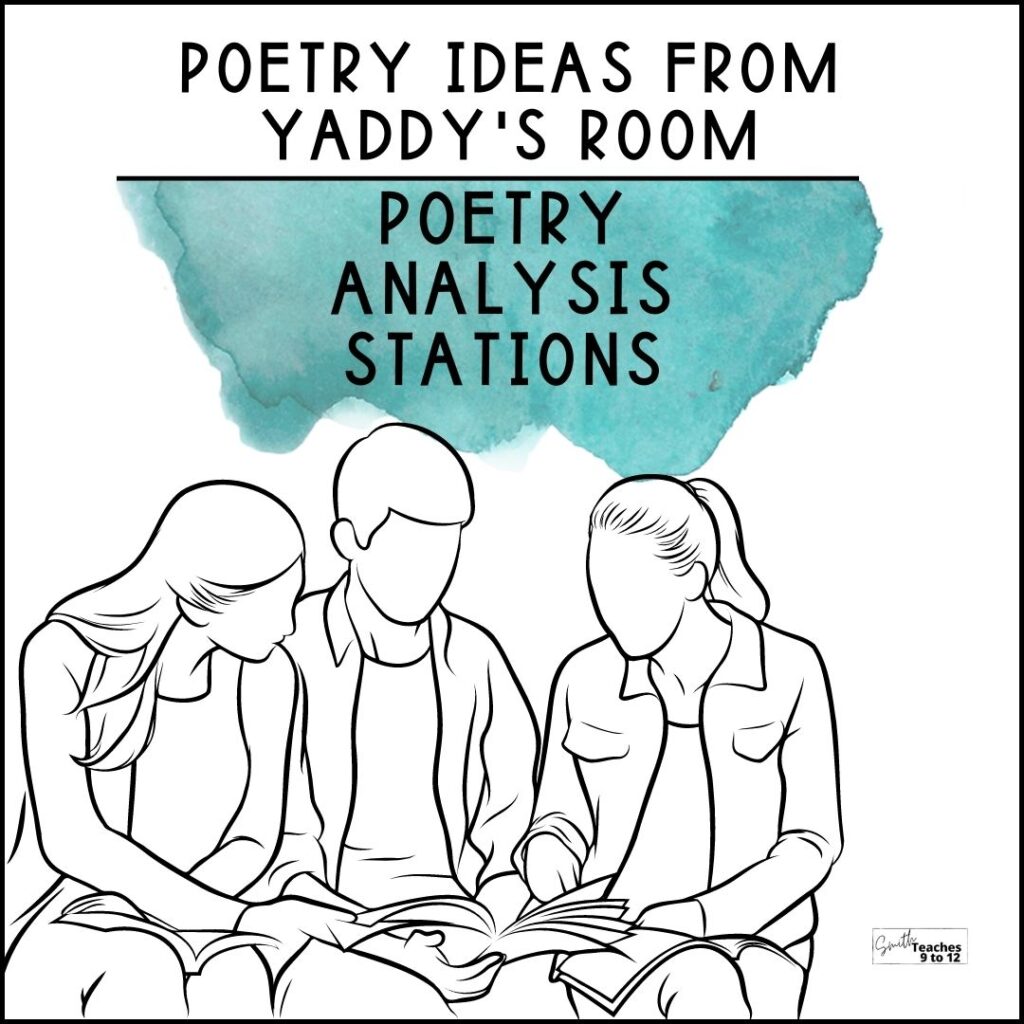
Poetry analysis stations are one of Yaddy’s, from Yaddy’s Room, favorites for teaching about poetry. Analyzing poetry is an essential part of developing critical thinking and literary analysis skills in your students. However, traditional methods of poetry analysis can be time-consuming and challenging to implement effectively. That’s where digital poetry analysis stations come in.
Digital poetry analysis stations are great not just for use in class, but also if you have absent students. Yaddy likes to use these digital poetry analysis stations that have clickable buttons and easy-to-navigate interfaces. These stations allow students to explore various elements of poetry, including setting, tone, theme, literary devices, imagery, and title analysis, at their own pace, reducing any frustration.
Station activities like this are also a wonderful way to encourage movement and collaboration, especially for tougher poems. Letting students collaborate in groups to decode a poem is a great way to foster collaborative critical thinking skills that will follow them into their careers after high school.
If you are wondering what poems to teach you can check out Yaddy’s recommendations for poems to use in high school here and a ready to use poetry unit here.
Poetry Idea 6: Drag-and-Drop Reviews with Music
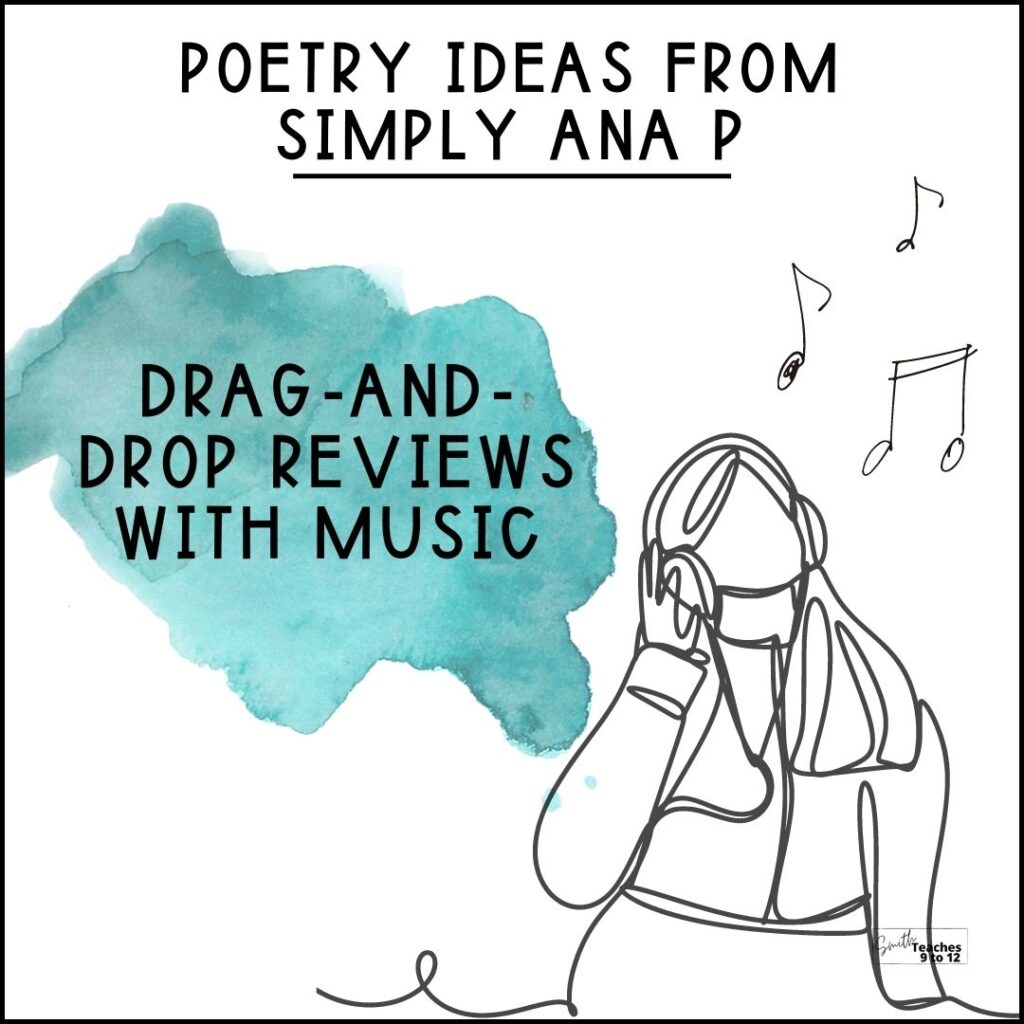
Interactive digital resources have quickly become part of Simply Ana P’s favorite gems to use in the classroom. One of her all time favorites are drag-and-drops on Google Slides.
While this type of activity can be used to review almost any content or unit, she especially recommends it for poetry units and uses song lyrics in this case to have students review poetic devices, including figurative language.
Students will definitely start smiling and singing to familiar lyrics while reviewing poetic devices, and as such, the engagement will thrive.
You can ask students to submit their favorite songs and choose lyrics from there, choose your own set of songs, or do monthly reviews, each with a different theme like 90s songs, country songs, Swiftie Vibes, etc. You can use it regularly, or make it a competition to see who can get them all right first and/or who can also name some of the songs the lyrics come from! The possibilities are endless.
And if you don’t have time to create your own, Ana has her best-selling one listed and ready-to-go here.
In any method, you can’t go wrong with music in a poetry unit!
Poetry Idea 7: Spoken Word Poetry
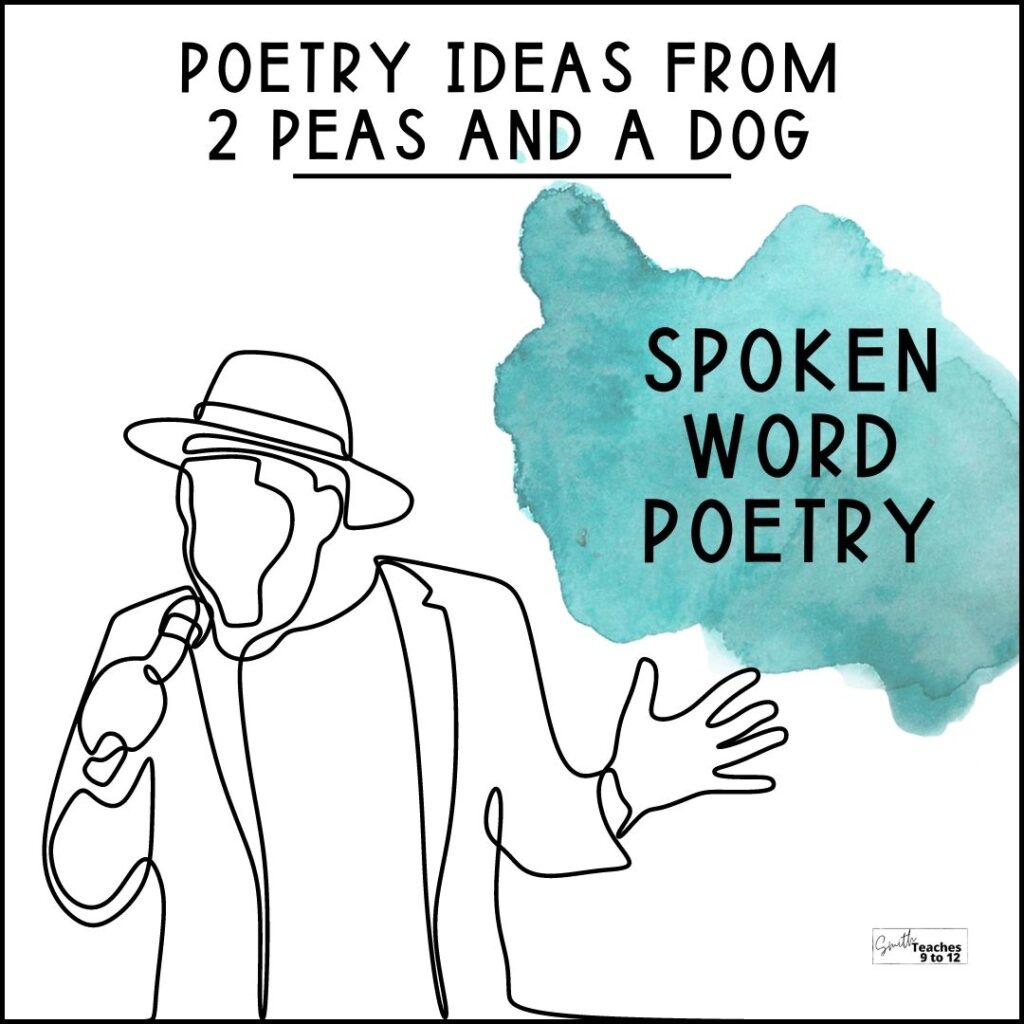
Too many students groan when you tell them you are starting a poetry unit or integrating poetry into your units. This is probably because they have not been exposed to all of the fun types of poetry that exist.
Kristy from 2 Peas and a Dog feels it is important to maintain poetry unit engagement with your students when using this literary form. One of the best ways to get students invested in poetry is to introduce them to spoken word poems. This is also a great way to diversify your poetry curriculum.
I was not super familiar with this poetry genre, but then I saw Amanda Gorman perform her poem “The Hill We Climb” for President Joe Biden’s inauguration in January 2021. Since then I have looked for other spoken word poems to use with my students.
I love the poem “ When Love Arrives” by Sarah Kay & Phil Kaye. Another great spoken word poem is “Ode To Our Ocean” By Amanda Gorman. Prince EA is another great spoken word artist to introduce your students to.
Check out this blog post on best middle school poems for lists of other poems you can use with your students.
Poetry Idea 8: Light Up Your Poetry Lesson with Glow Sticks
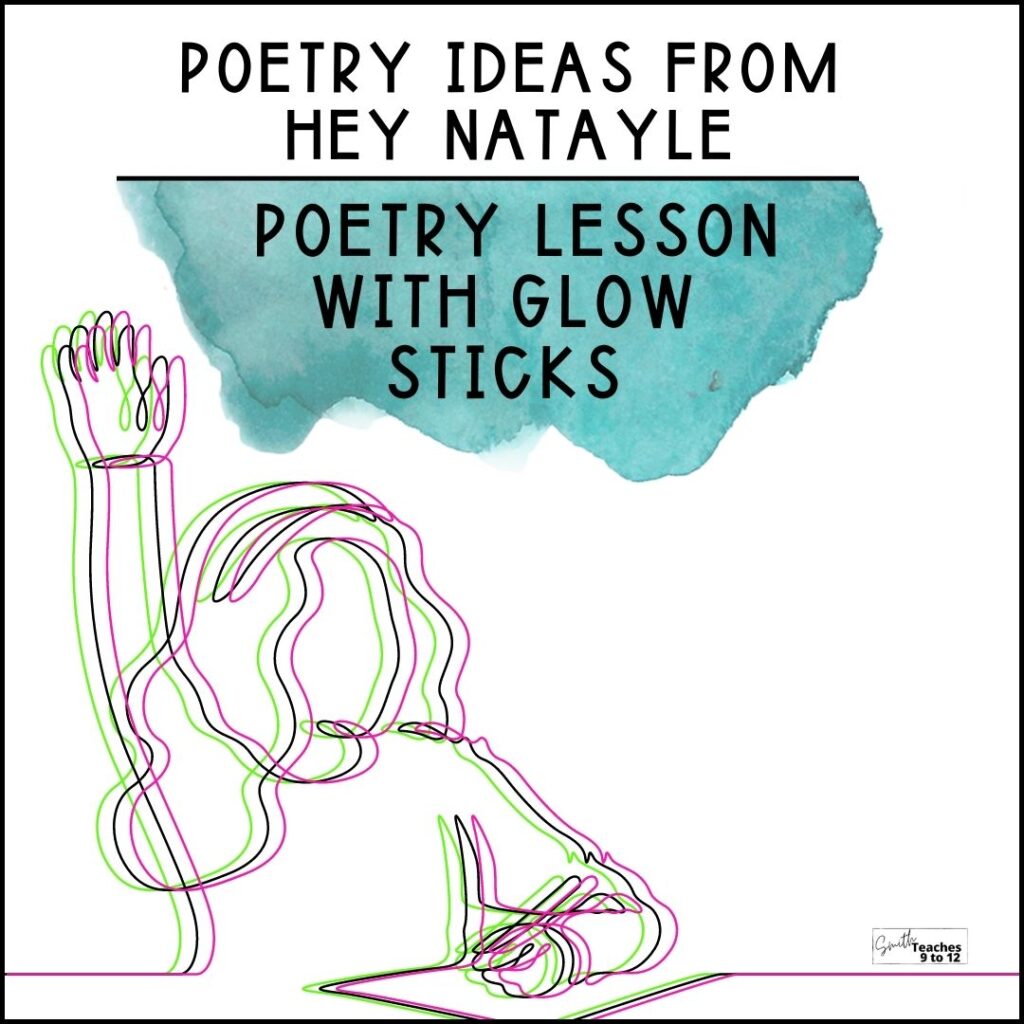
Don’t miss the chance to add some excitement to your final poetry lesson with a Glow Day! Hey Natayle is a fan of classroom transformations and multisensory learning, and in her latest blog post, she shares how a few black lights and neon highlights transformed her final poetry analysis into an engaging experience that had her students pumped up about poetry.
Whether you have access to black lights and glow sticks or not, Natayle has you covered. She shares budget-friendly recommendations on how to make a Glow Day work for any classroom. Sure, black lights and glow sticks take the experience to the next level, but you can also use neon projections, highlighters, and glowing Google Slides to create an immersive learning experience that your students will love.
Natayle also provides insights into the meaningful work that her students engage in on their poetry Glow Day. She has students rotate through four stations, peeling back the complex layers of a poem one at a time. The stations include exploring poetry form and structure, examining poetic devices, analyzing the speaker’s point of view, and understanding the theme.
By giving your poetry analysis activity a neon glow-up, you’ll capture your students’ attention and get them excited about learning. Check out Natayle’s full post for more details on how to make this happen. With a bit of creativity and some budget-friendly materials, you too can create a memorable and engaging learning experience for your students.
Poetry Idea 9: On-campus Poetry Field Trip
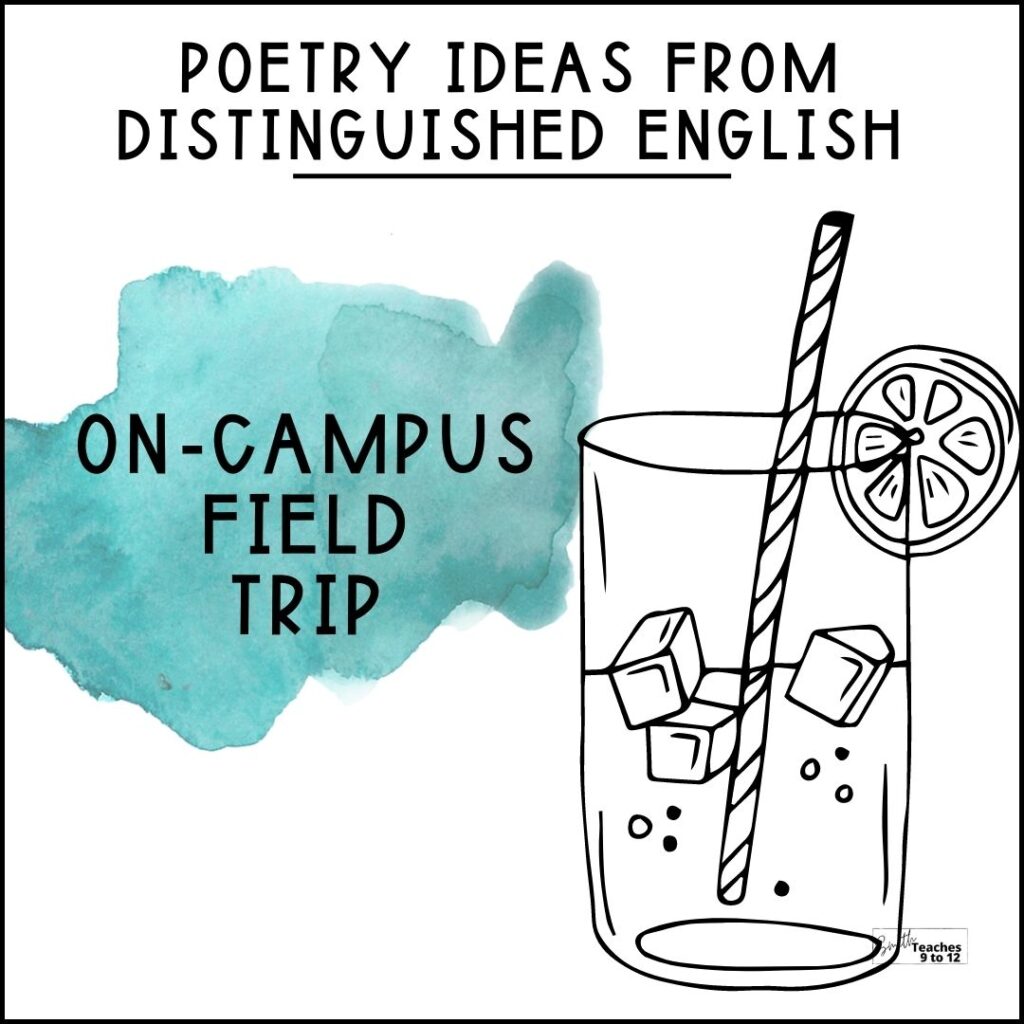
A couple of years ago, Olivia from Distinguished English helped her students organize a 4D poetry experience for the younger grades on the campus. Her students picked poems with lots of imagery and created an “experience” for each poem. The little kids who visited had wind blown through their hair with fans, they got to taste cold lemonade, and they got to walk through flower-scented air freshener. Olivia’s students read the younger children each line of the poem as they experienced the sensory imagery from that line. This on-campus field trip was a huge hit! The little kids enjoyed experiencing poetry in a fun way, and Olivia’s students understood imagery much more fully through the experience. You can grab your own 4D Poetry Kit here!
Poetry Idea 10: Connect Poetry to Pop Culture
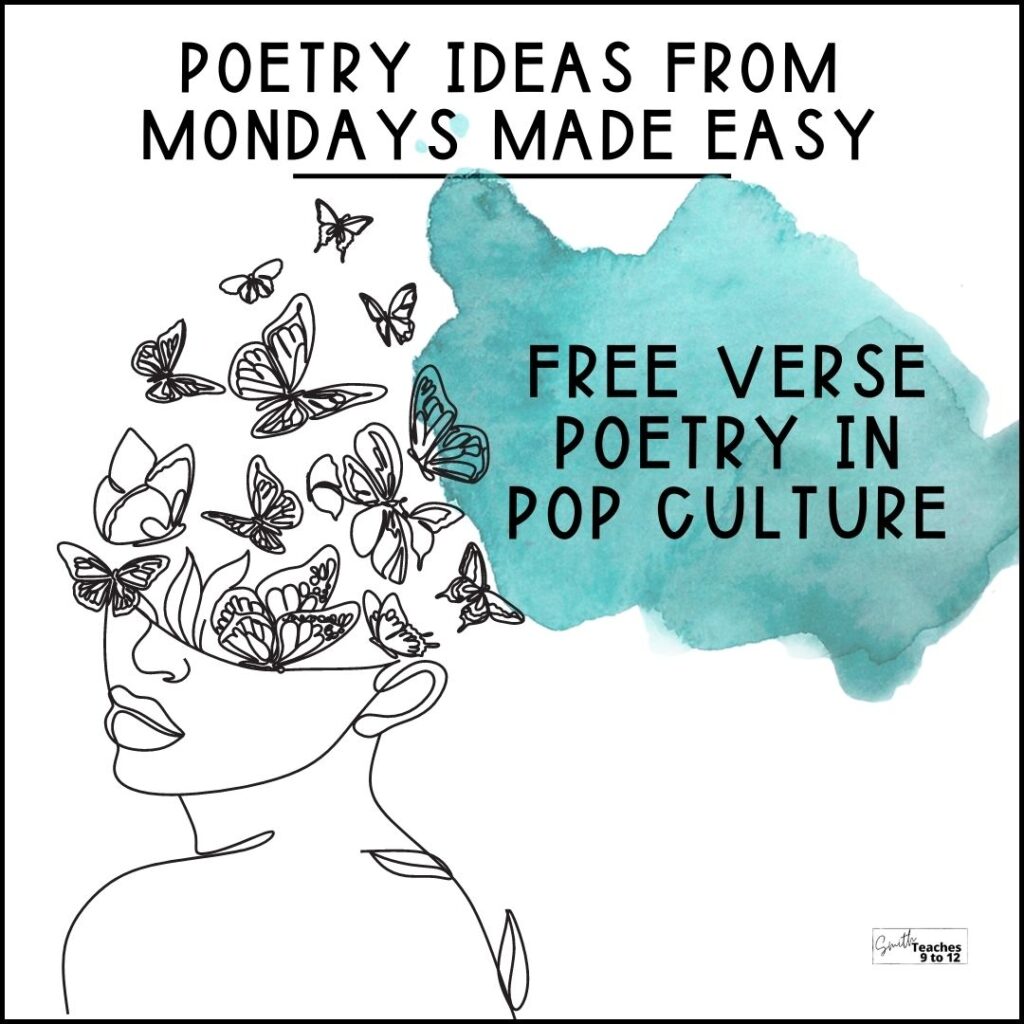
Daina from Mondays Made Easy loves to bend the rules by teaching students about free verse poetry. Free verse poetry can be daunting because there are practically no limits; however, it has also become highly relevant in popular culture. This is partly due to the wave of Instagram poets that have become well-known in the last few years.
Take Rupi Kaur for example. You might know Kaur from her popular publications Milk and Honey, The Sun and Her Flowers, and Home Body. If you haven’t heard of her name, you could probably recognize one of her many illustrative free verse poems that have gone viral on social media.
Another example is Kate Baer, who has popularized the concept of erasure poetry, also known as “blackout poetry.” Baer received criticism for her appearance online – primarily from paternalistic audiences on the internet. She transformed this criticism into art by screenshotting their comments and covering selected words with white space to convey her own message.
Given the endless possibilities, free verse poetry is an exciting form to teach how to write poetry. Students can choose to imitate the styles of Kaur and other Instagram poets using illustrative free verse. This is the perfect option for the creatives in your classroom. Blackout poems are another great fit for English Language Learners or students who enjoy word puzzles.
This free verse writing workshop includes lessons on the different types of free verse poetry. It showcases examples from Kaur, Baer, and other poets in this new wave of poetry. To read more about poetry writing workshops, check out this blog post.
Poetry Idea 11: Variety for Reluctant Readers
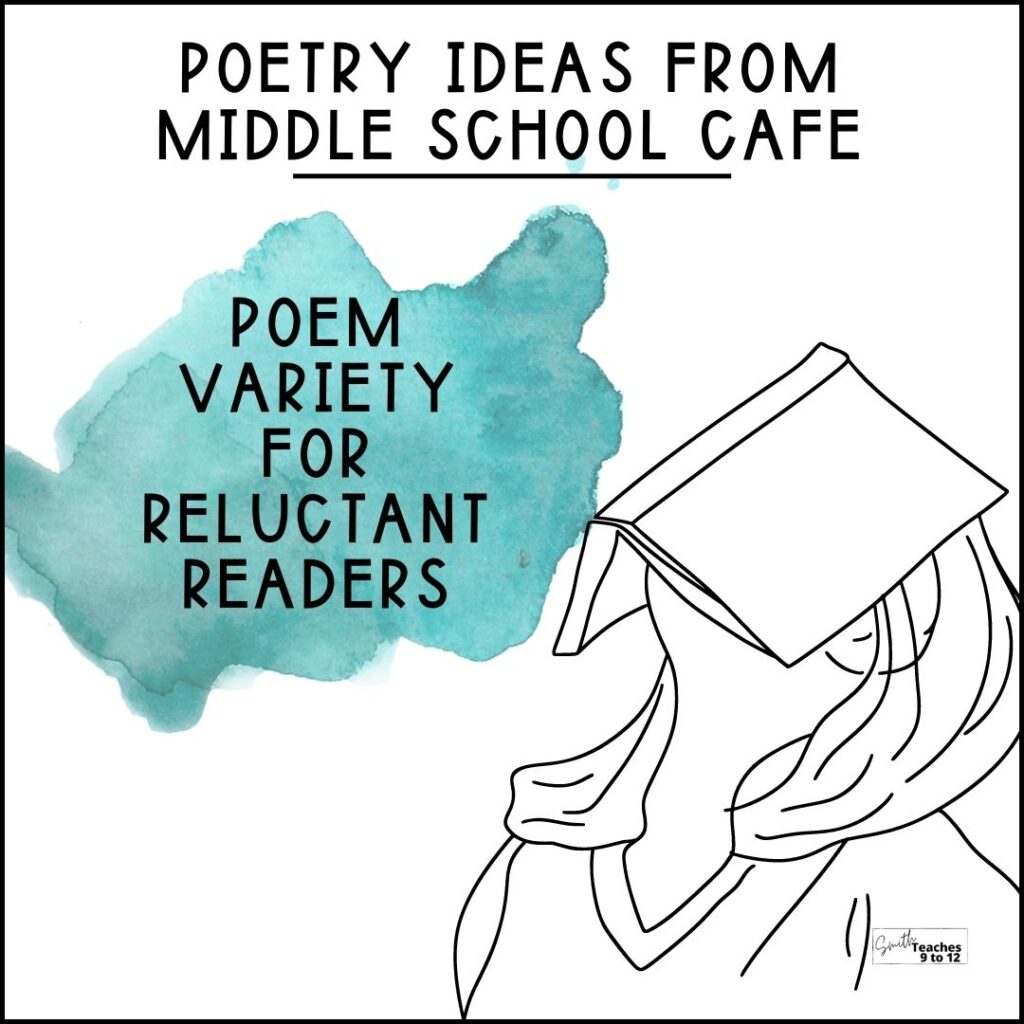
One of the things that reluctant readers find intimidating is the length of books. Carolyn from Middle School Cafe has learned that graphic novels are a great way to engage a reluctant reader but not all students are interested in books with pictures, so what can you do? Poetry is a great option!
Poetry is great for engaging reluctant readers because it offers a unique way of looking at language and storytelling. Unlike traditional novels, poetry often relies on condensed language, wordplay, and vivid imagery to create an emotional impact. This can be especially appealing to middle school students who may not be interested in reading lengthy novels or non-fiction texts and don’t like graphic novels. Additionally, poetry can be read in short bursts, which means students can get a quick win!
Another advantage of using poetry to engage reluctant readers is that it offers a wide variety of topics and themes that can resonate with students. Whether it’s a poem about nature, love, social justice, or personal identity, there is likely a poem out there that will capture a student’s attention and speak to their individual experiences. This can be especially important for students who may not see themselves represented in traditional texts.
When it comes to capturing the attention of reluctant readers, Carolyn will try just about anything to help pair her student with that perfect book. If you are looking for more ways to engage reluctant readers head over to the Middle School Cafe Podcast where she discusses a variety of ways to engage students in reading!
Poetry Idea 12: Poetry. All. The. Time!

For me – Lesa – the best option for poetry is to use it all of the time in class. Use it for bell ringers, SEL moments, grammar lessons, poetry pairings, creative writing, attendance questions, and even analysis!
Making poetry a bigger part of your lesson plans throughout the school year is one my own tried-and-true poetry ideas that will reduce the scariness of poetry for teachers and students!
This is why I put together this poetry e-book with 5 poems, including spoken word, for each month of the year. The FREE resource includes 8 adaptable activities to use with any poem. PLUS, I send out a full poetry lesson every month using one of the featured poems.
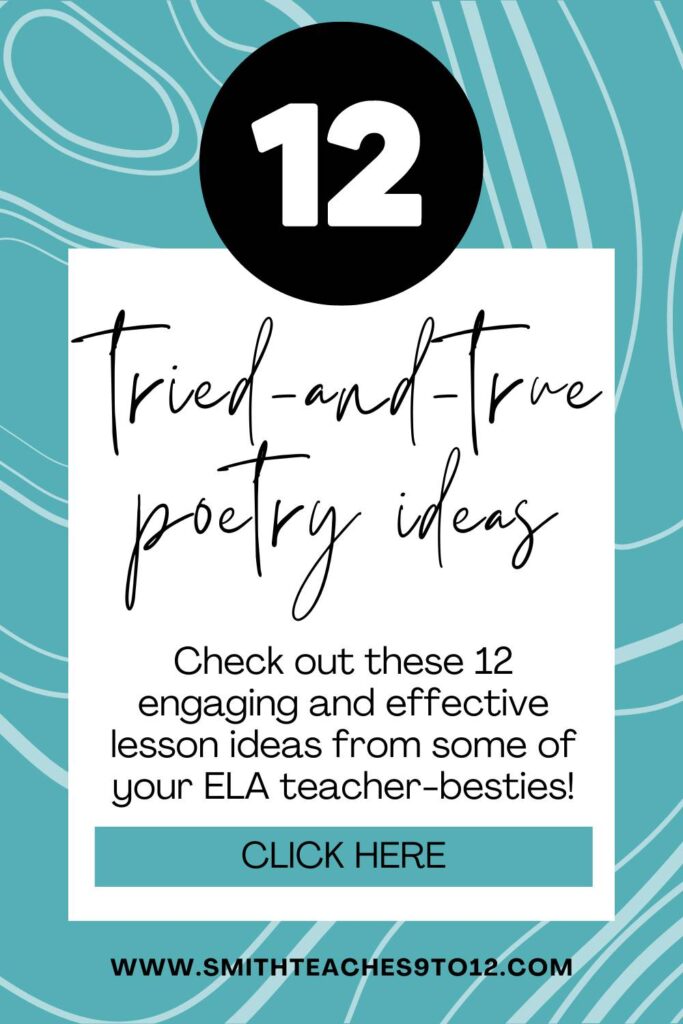
My goal is to help you feel more comfortable and MORE CONFIDENT with including poetry in your class. I hope that with this resource plus the 11 ideas shared from a great group of teachers, you will be able to find something to use at different points in your school year!

Related articles:

